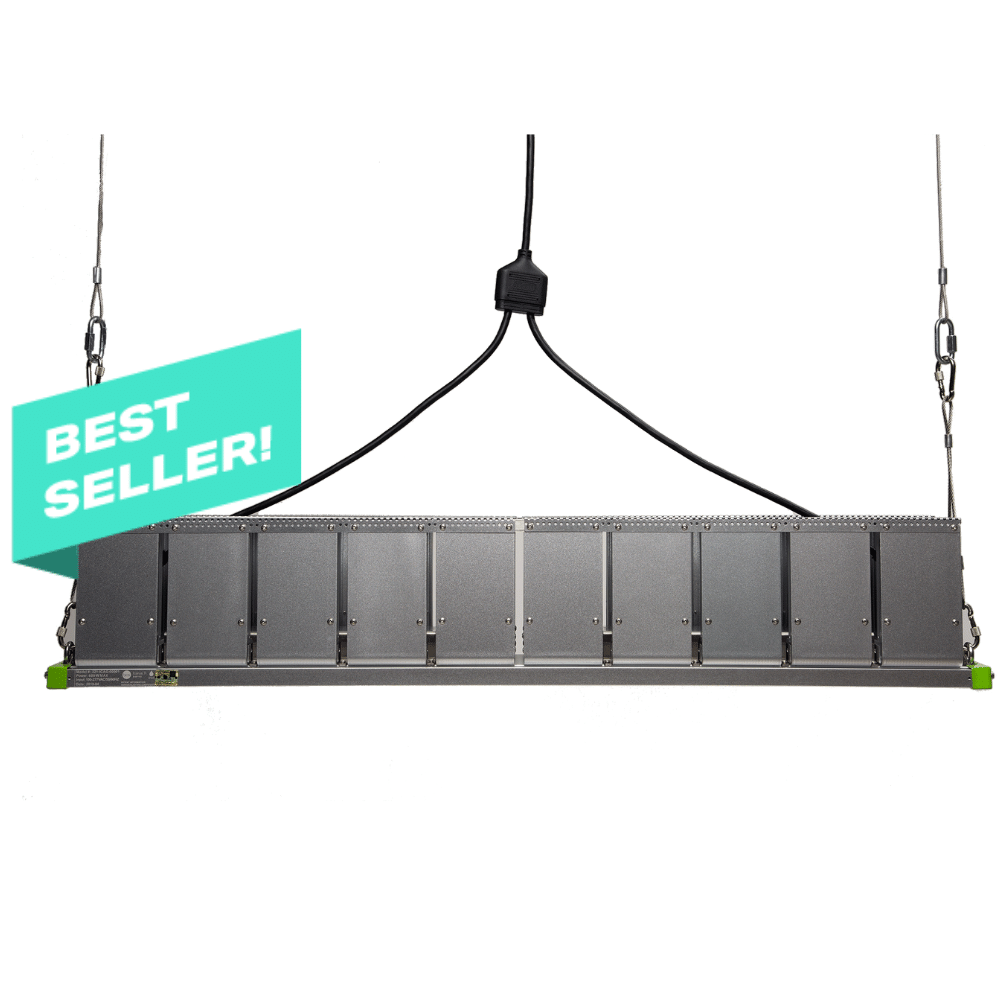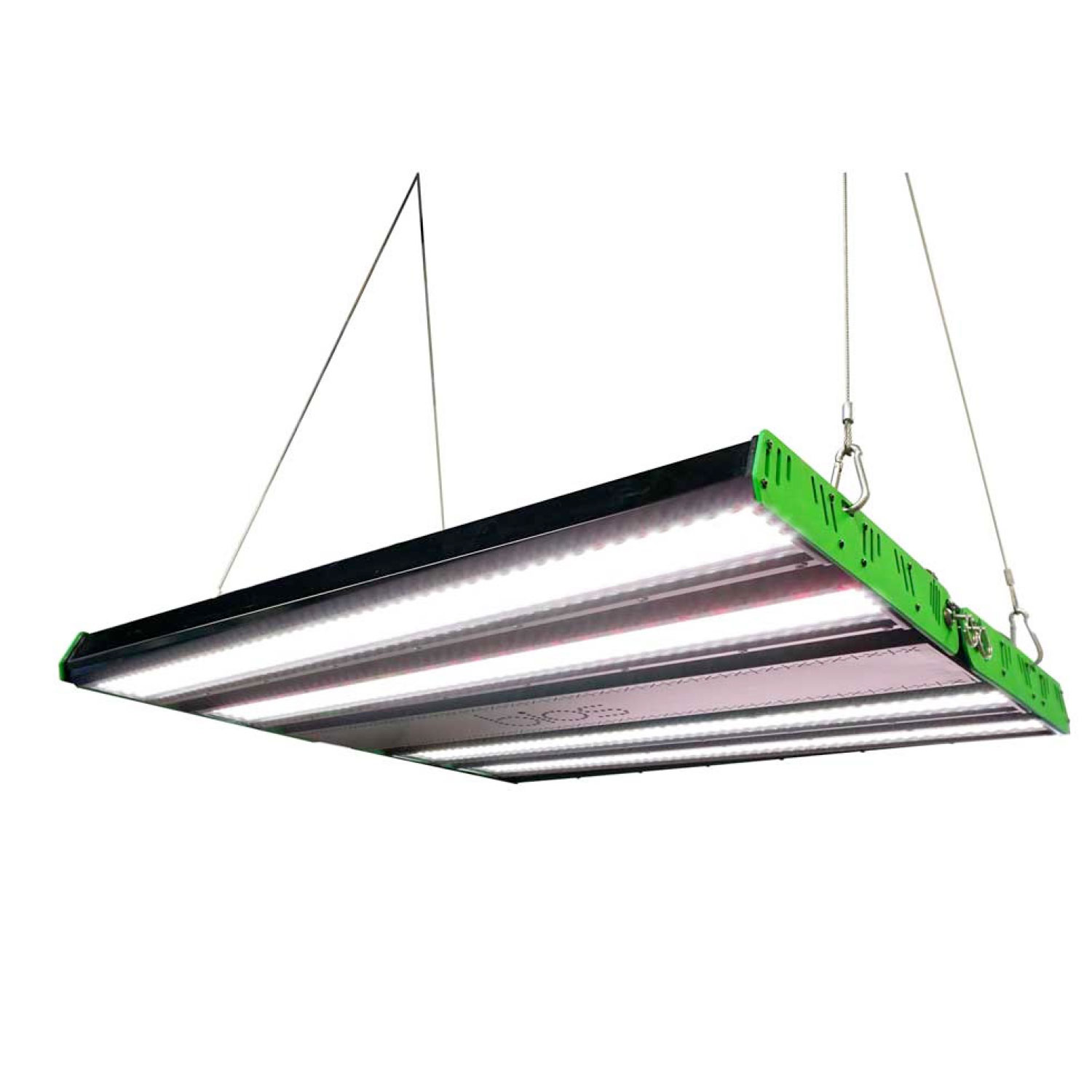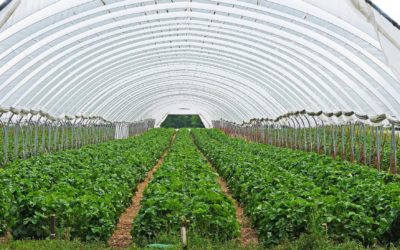One of the most critical challenges—whether for greenhouse managers or for horticulture aficionados—is to provide plants with enough photoperiodic sunlight for effective photosynthesis, so that they can grow optimally regardless of the geographical location and climate. Winter months even in supposedly warm-weather California can have a Daily Light Integral (DLI) of 10 to 20, which is insufficient for optimal plant growth. As a result, supplemental electric lighting is required in most cases to accelerate flower development, create hardier stems, increase chlorophyll content, and also increase leaf count.
Light acts as a key environmental signal and a critical source of energy for plant growth, with plants using light for both photosynthesis and development. Lighting parameters influence germination, seasonal and diurnal time sensing, plant stature, growth habits, and transition to flowering and fruit ripening. It is therefore important to control the quality, quantity, intensity, direction, duration, and wavelength of the light reaching the plants, in order to ensure effective growth, sustained development, and maximized crop productivity.
Main Reasons Why Controlling Light Is Vital for Plant Growth
Light Uniformity
Light uniformity refers to how evenly the light is distributed across a given growing area, and should be an important consideration—just as light intensity and quantity is—for all types of plant lighting installations. Light uniformity can regulate crop growth, plant development, flowering schedules, and water distribution. If the illumination system for a growing area is not designed to distribute the light in a uniform manner, the crops will dry out or develop at different rates depending on whether they are getting access to more or less light across the same area. If some plants receive more light than others and exhibit uneven growth patterns, that in turn can lead to uneven shading.
Light uniformity is affected by a number of factors, including (but not limited to) the light source used, the reflector design, the type of fixtures, the light distribution, beam angle, fixture quantity, fixture spacing (how close together they are), and the distance of the fixtures from the plants themselves.
A uniform blanket of light can be achieved by equipping the light fixtures with light bars, which can be easily arranged according to desired spacing to achieve effective intra-canopy light penetration. The luminaires with their source type (ideally LED) and light bars should be mounted at an optimum height and spacing—either via calculations or by following manufacturer recommendations—to deliver a uniform layer of light (without creating hazardous light intensity levels or hot spots) over the full plant canopy, even as the canopy grows and changes over time. These techniques will then translate into increased profits per harvest, and will maximize dry growth yields on a continuing basis.
Light uniformity also affects the efficiency of any prescribed nutrients, since plants receiving lower light annually (compared to the targeted average) will consume more nutrients or dry faster due to uneven water use, and that will reduce profits.

Lower Energy Costs
The electric lighting—used to either supplement the daylighting on the plants or act as their primary source of photosynthesis and development—can be a significant portion of the total energy use, and will impact your bottom line accordingly. In addition to the investment in the lighting system itself for optimal crop growing needs, it is important to choose a light source for not just its high output, but also for its maximized energy efficiency. The efficiency of the lighting system is also negatively impacted by the amount of heat it produces.
The ability of LEDs to produce a lot of light at low cost makes them the ideal lighting source for all kinds of horticulture and crop growth systems. The efficacy (lumens per watt) of LEDs has increased dramatically in the last decade, whereas the cost per lumen has decreased significantly at the same time. In addition, the small form factor of LEDs allows a wide variety of optics, reflectors and housings to be designed around them, enabling much more precise light generation with greater efficiency and at a lower cost.
The plants’ leaf surface temperature (LST) is very important to measure accurately, and is typically warmer than the ambient air temperature. A 75ºF ambient air temperature under HID (MH or HPS) systems generally leads to an LST of about 85º-88ºF. The higher energy efficiency of LEDs ensures that they are much cooler (irradiating much less heat) than their HID equivalents—resulting in the ambient air temperature becoming about 10º cooler than comparable HID lighting systems. Cooling costs are therefore typically lower when using LED fixtures, especially when integrated with automated controls and ventilation strategies. When the fixtures run cooler, less air conditioning is required for the space, less water gets evaporated due to excess heat, the plants will retain moisture better, and they will be protected from “light burns”. At the same time, the LST should measure the same regardless of whether the plant is being lighted by HID or LED systems. In order to enable optimized metabolic rates with the cooler-running LED systems, the temperature set point at the grow facilities should be raised by about 9°F to achieve the same optimal LST (about 82-85º for cannabis plants). LED systems can therefore further reduce cooling-associated costs by requiring warmer ambient growing conditions.
Since LEDs produce much less waste heat compared to HID lamps, they can be placed much closer to crop surfaces without the risk of overheating and related stress for the plants, while still ensuring uniform light distribution. This means that LED systems can be designed with a lot more flexibility—such as horizontal, vertical, multi-layer, intra-canopy, or inter-crop lighting layouts.
The unique energy-efficient features of LED enable innovative strategies that were hitherto not easy to achieve with traditional sources, and provide better uniformity, higher quality, and increased fruit yield for the growers.
Fine-Tuned Color Distribution
Over the last century, scientists have observed how wavelengths, intensities, and photoperiods together shape plant output. Plant photoreceptor actions and their signaling components can influence growth at different developmental stages, and are therefore excellent targets for altering productivity and yield. Traditional lighting systems typically offer only binary on-off control; in other words, when they’re turned on, they emit the same spectral output for every plant, even if you’ve got different varieties in the same space and even if each variety receives a different cocktail of nutrients.
LED technology is however well suited for plant lighting applications, due to its full light spectrum capabilities. One of the biggest advantages of LED lighting is that it has highly customizable wavelength capabilities, without the cumbersome (and expensive) need to regularly change fixtures. LED grow lights can affect a plant’s physiology and morphology via the application of specific light wavelengths during specific times which are most appropriate for optimizing desired crop traits. For example, growers can now purchase horticultural LED fixtures that provide a narrow-band red and/or blue light to control certain plant traits (for example, supplemental far-red light used for cucumber vines to promote better stretching, or a mix of red and blue spectra for more compact lettuce plants), or a custom-designed broad-band white-light spectrum that maximizes photosynthesis and growth for most plants.
Product Quality
With the networking and control capabilities built into LED grow lights, horticulturalists and growers can craft proprietary light programs to optimize brightness and color distribution, and enhance individual characteristics of the plants that will make them most marketable.
LED technology enables light quality to be manipulated on a commercial scale, and creates opportunities to enhance crop quality through precise manipulation of the lighting regime—by influencing each crop variety’s size, yield, color, spread, and even taste.
Color Effects on Plant Growth
Grow light spectrum refers to the electromagnetic wavelengths of light produced by a light source to promote plant growth. Photosynthetic active radiation (PAR) is the range of electromagnetic radiation that plants use for photosynthesis (a wavelength range of 400 nm to 700 nm). The amount of PAR falling on an individual plant at any given second is defined as photosynthetic photon flux density (PPFD), measured as micromoles per square meter per second (μmol/m2/s). Note that a PPFD measurement taken below a light source will vary based on its distance from the plant, and is also based on the area of the space under consideration.

Plants perceive different wavelengths of light using distinct photoreceptors. Plants contain pigments that show an affinity to photons of particular wavelengths, and those photons in turn have different energy levels depending on the wavelength. Therefore, the spectral absorptance of the plant plays a critical role as to whether the measured PPFD value is effective in photosynthesis.
Plants have three primary photoreceptors that respond to different parts of the spectrum; the phytochrome pigment responds to the red and far-red part of the spectrum, cryptochrome responds to green and blue light, and phototropin responds to blue light—all controlling plant growth, gene expression, and the transition to flowering development in various ways. The existence of distinct photoreceptor families provides opportunities to selectively activate individual pathways, thereby precisely controlling overall development.
Unlike humans—who can only detect visible light spectrum wavelengths (380-740nm)—plants on the other hand can detect wavelengths which include visible light as well as beyond, such as UV and Far Red spectra. Light spectra will affect plant growth in different ways depending on environmental conditions, plant species, etc. Typically, chlorophyll, the molecule in plants responsible for converting light energy into chemical energy, absorbs most light in the blue and red spectra—both of which are found in the peaks of the 400-700 nm PAR range—for photosynthesis. Other spectra of light, like greens/yellows/oranges, are less useful for photosynthesis due to the amount of chlorophyll-b, absorbed largely from blue light, and chlorophyll-a, absorbed largely from red and blue light.

Red Light
Phytochromes, which are the principal receptors for light in the red/far-red region of the spectrum (600–750 nm), play an essential role in regulating seed germination, the blooming cycle, root development, and shade avoidance. In green plants, light is a crucial factor in determining the establishment of an emergent seedling. Maximizing photosynthesis using supplementary lighting rich in the red/far-red spectral region during early development and/or under dense canopies can be critical for seedling survival.
Red light spectrum (600-700nm) is considered the most efficient at driving photosynthesis—especially in the flowering stage for biomass growth, which is particularly important to cannabis growers—as it’s highly absorbed by chlorophyll pigments. Red light wavelengths (particularly around deep red 660nm, since that’s where a plant senses bright sunlight exposure and its chlorophyll absorption peaks) encourage stem, leaf, and general vegetative growth—and especially the elongation of leaves and onset of flowers.
Far-red light spectrum (700-850 nm) can also affect plant growth; one way is by initiating a shade-avoidance response. From 730nm and beyond, there is a higher ratio of far-red to red light, and so if a plant detects “shade” from another plant or leaves higher up the canopy, then elongation of its own stems and leaves occurs.
Far-red can also promote flowering, and in certain plants, has been shown to increase fruit yield. In short-day plants like cannabis, which rely on longer periods of darkness, 730nm can be used at the end of a light cycle to promote flowering. Many growers are experimenting with interrupting the dark cycle with bursts of red light to boost growth and flowering.
Blue Light
Blue light spectrum (400-500 nm) is widely responsible for increasing plant quality, especially in leafy crops. It promotes the stomatal opening, which regulates a plant’s retention of water and allows more CO2 to enter the leaves. This can affect leaf movement, leading to flatter and expanded leaves, which results in a more efficient surface for light absorption.
Blue light also drives peak chlorophyll pigment absorption (peaking at 439 nm and 469 nm), required for photosynthesis. The 400-500 nm blue light spectrum is essential for seedlings and young plants during vegetative stages as they establish a healthy root and stem structure—and especially important for reducing stem stretching when necessary.
In addition, blue wavelengths affect phototropism (the orientation of the plant in response to light, either towards or away from the light source).
Broad Spectrum (White) Light
The ideal grow light spectrum for plants depends on several factors. In some crops, blue light can benefit nutritional levels and coloring, while a higher red to far-red ratio can help with leaf size and flowering. While red is generally the most responsive light spectrum for plants, it’s important to note that its efficacy really steps in when in combination with other PAR wavelengths. A balanced pairing with blue light is necessary to counteract any overstretching, like disfigured stem elongation. Certain plants (such as cannabis) use not only the 400-700 nm PAR-spectrum light for photosynthesis, but also the wavelengths outside of this range.
Individual light combinations should therefore be adjustable throughout the life of a plant to optimize desired traits. Broad spectrum white lighting—often referred to as full spectrum lighting—means the complete spectrum of light given by sunlight. This means that the wavelengths of broad spectrum lighting include not just the visible 380-740nm wavelength range (which we perceive as color), but also invisible wavelengths such as infrared (IR) and ultraviolet (UV). Effective broad spectrum light can help accelerate flowering, increase nutrition, and speed up the rate of growth.
One big advantage of commercial broad spectrum LED grow lights is that they can be wirelessly programmed to generate certain wavelengths and intensities in specified periods during the day or night, or at certain intervals in a 24-hour cycle. This makes it ideal for growers, since they can isolate specific spectrum colors depending on the types of crops and growing conditions. Commercial LED grow light settings often work in conjunction with a grower’s HVAC systems too.
By using full spectrum LEDs to select the exact quantities of red and blue light, chlorophyll pigments can absorb more of the light that they need. This means that when used strategically, bigger leaves and better flowering periods can occur without unnecessary stress.
How BIOS Lights Maximize Photosynthesis and Growth
BIOS is constantly developing its knowledge and research of how various light spectra work best on specific crops and strains—and at which points during a plant’s life cycle. Their Icarus line of LED grow light fixtures are designed and developed using detailed scientific research, giving growers true control of an ideal broad “white” spectrum light along with the highest PAR photon efficacy in an industrial grade fixture—for higher optimization of the yield, quality, and variability of their plants.
The BIOS Icarus fixtures are available in various styles and sizes for a range of crop growing environments—whether indoor open-bed, indoor top light, vertical farming, or greenhouses.
Here are some of the many benefits of BIOS Icarus grow light solutions:
- Superior PAR output, photon efficacy, and light uniformity;
- Scientifically engineered spectrum for optimal PAR photon efficacy and plant growth;
- Fully assembled, UL wet-rated, and durable industrial grade construction;
- Enhanced crop yield and quality;
- Total energy usage reduced by more than 50%;
- 1:1 1000W HPS replacement;
- More than 50000 hours lifetime, with no lamp changes;
- Smooth optics for spot-free cleaning, and superior light delivery over the life of the fixture;
- Dimmable for all phases of plant growth/production.






